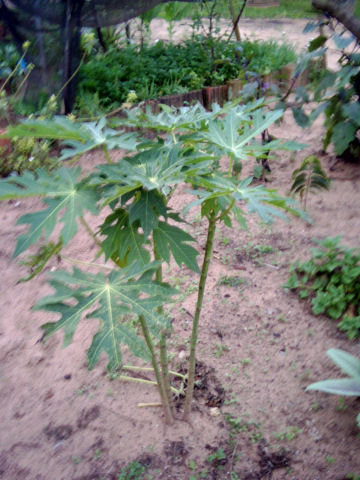

Carica papaya (Papaya, Melon Tree)
Papaya (Carica papaya, also called Melon Tree or Papaya Tree) is one tropical herbaceous perennial which belongs to the family Caricaceae and supposedly originated from Mexico.
The plant is falsely denoted as tree, because it has one treelike habitus. The papaya is originally originated from the lowlands and coast regions of the tropical America, its name is from the language of the Awak Indians. Already in the early 16th century the Spanish people began to grow this plant also on the Antilles and the Phillipines. Today it is grown worldwide in the tropics and subtropics. Important growing areas are Australia, India and Central and South America (Costa Rica, Brazil etc.) and also Africa (Kenya, Ivory Coast etc.).
The papaya is one huge, mostly unbranched, treelike erect plant. The solitary "trunk" which does not become woody, reachs growth heights of 17 to 33 feet. Because of the missing lignification, the form of the growth and the longlifetime the papaya cannot denoted as tree nor as shrub or herbaceous perennial. The newest special literature speaks about one "treelike herb", this are also the bananas. The leaves are arranged spirally around the trunk and are thrown after one certain time (anyway not in certain seasons), so that the trunk is beneath leafless and forms one "tuft" of leaves at the top. The large leaves have a diameter of 20 to 28 inches, they are pediculated and deeply lobate. At the total trunk, in the axils, are blossoms and then the fruits forming.
The fruit is elongate-oval, about 6 to 18 inches long and in the diameter of 4 to 12 inches wide and can reach one weight of 3 to 6 kg. In Europe is nearly only the Hawaiian or Brazilian papaya on the market, whose specimens do reach only 0.5 kg. The peel of the completely ripen berry is yellowish green, the pulp is light orange to pink and contains in the middle of the fruit black seeds, which are covered by one membrane. The seeds of the papay contain large amounts of papain, the proteolytic enzyme. They were used in the folk medicine in the past as deworming medicine and today in the form of powder to make the meat delicate. One similar effect will be made, when raw meat is wrapped into the leaves from the papaya tree or taken into fresh papaya juice (for this the fresh pineapple juice has the same status).
Recently are several new specimens planted in our yard.

Carica papaya in our yard in September 2008, Unfortunaely this specimen was
removed because of one disease. But I had sown in-situ to replace the plant.

Some of the recently planted specimens of Carica papaya
in August 2009, they were planted by Antonio, the
in-situ sown seeds didn't germinate.
Back to the Agricultural Plant List
Created by Joachim Jaeck on December 1st, 2009